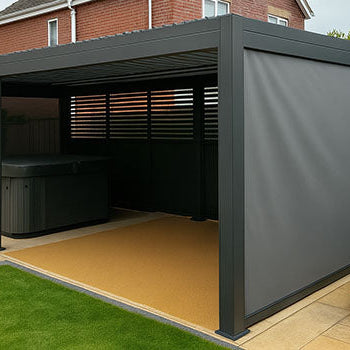Pergolas: charming backyard additions or surprise permission pitfalls? Short answer, if your pergola is under 2.5m high and doesn’t take up more than half your garden, you probably won’t need permission. But location, size, and whether you're in a protected area can quickly change that.
Keep reading for the must-know rules, common planning traps, and how to avoid awkward neighbour disputes before you even pick up a hammer.

Understanding Permitted Development Rights for Pergolas
What are Permitted Development Rights?
Think of Permitted Development Rights (PDRs) as the UK homeowner’s secret shortcut. They let you make minor changes to your home, like adding a pergola, without going through full-blown planning permission.
But don’t get too comfortable. These rights come with strings attached. You’ll need to stick to certain limits on height, placement, and how much space your pergola eats up.
Break the rules? You’re back in the planning queue.
How These Rights Apply to Outbuildings like Pergolas
Pergolas fall under the “outbuilding” category in UK planning law, alongside sheds, greenhouses, and summerhouses.
If your pergola is freestanding, open-sided, and meets the height and size rules, you’re likely in the clear. But if it’s pushing boundaries (literally), or located somewhere sensitive, the rules change fast.
Bottom line: follow the PDR limits and you’ll likely avoid red tape. But don’t assume, check.
Key Conditions for Building a Pergola Without Planning Permission
The Height Restriction: Staying Under the Limit
So, what is the legal height for a pergola in the UK?
The golden number is 2.5 metres. If your pergola is within 2 metres of your boundary, it must not exceed this height.
Go over? You’ll need planning permission. Keep it low and light, and you’re probably good to go.
The Location Rule: Proximity to Your House and Boundaries
Planning permission gets more likely when pergolas start creeping close to boundaries or neighbours' fences.
If it’s within 2 metres of the boundary, the height limit applies. If it's behind your house, you’re usually fine. But out front? That's planning territory.
One homeowner in Surrey found this out the hard way when their stylish front-garden pergola had to be removed, despite the neighbours loving it.
The Size/Footprint Limitation (% of Garden Coverage)
Let’s talk numbers. How big can a pergola be without planning permission?
In short: your pergola must not take up more than 50% of your garden. That includes all outbuildings, not just the pergola.
Got a shed, conservatory, or garden office already? They count too. Overdo it and the council may come knocking.
Can it be Placed in Front of Your House?
Do pergolas need council approval in the UK if they’re in the front garden? Almost always, yes.
Front gardens are in full public view, and councils are keen to protect the street scene. Even a sleek timber pergola can be seen as out of place if it’s too close to the pavement.
Stick to the back garden unless you’re ready for paperwork.

When You WILL Need Planning Permission for a Pergola
If Your Home is a Listed Building
If your house is listed, you’re playing by a whole different set of rules.
Do I need planning permission for a pergola UK-listed property? Yes, even for small, subtle garden features. That’s because any changes that could affect the character of the building need consent.
A small mistake here can lead to serious fines. Always speak to your local planning authority first.
If You Live in a Conservation Area, National Park, or AONB
Do you need planning permission for a pergola in a conservation area? Most likely, yes.
These areas are tightly controlled to preserve natural and historical beauty. Even if your pergola ticks all the usual boxes, you’ll still need to check with your council first.
Some regions ask for detailed plans and materials before giving the green light. In short: no guesswork here.
If the Pergola Exceeds the Specified Height or Size Limits
Big pergola dreams? Bigger chance of needing permission.
If your structure exceeds 2.5 metres in height, is too close to the boundary, or covers more than half the garden, it’s not permitted development anymore.
This also includes pergolas with a roof, especially fixed ones. Councils may view them as more permanent structures, which means more rules.
You can view different pergola roof styles here to get an idea of what's typically compliant or adjustable.
If it is Attached to the Side of Your House Facing a Road
If you’re thinking of building a pergola that’s attached to your house and faces a road, it will definitely need planning approval.
These kinds of builds can alter the appearance of the house from the street, which is something councils take seriously.
Better to ask first than rebuild later.
Building Regulations and Pergolas
The Difference Between Planning Permission and Building Regulations
It’s easy to mix these up, but they’re two different beasts.
Even if you don’t need planning permission, you may still need to follow building regulations, especially if you're running electrics or adding permanent features.
Are Building Regulations Typically Required for a Standard Pergola?
For a simple, freestanding wood or metal pergola, building regulations usually don’t apply.
But if you’re building on top of an existing structure, attaching it to the house, or adding a solid roof, things can get more complicated.
And if you plan to install outdoor electrics, lights, heaters, sound systems. It’s best to check with your local Building Control team.

How to Check and Be Certain
Where to Find Official Government Guidance (Planning Portal)
If you want the full legal lowdown, head straight to the Planning Portal. It’s the UK government’s go-to guide for home improvement rules.
They’ve got clear examples, diagrams, and checklists that break down what is and isn’t allowed.
Bookmark it before you start sketching.
The Importance of Contacting Your Local Planning Authority (LPA)
Every council interprets the rules slightly differently. So before you order timber or book a builder, get in touch with your Local Planning Authority (LPA).
A quick phone call or email can save you weeks of frustration later.
Some areas have stricter views on conservation or design, especially in historic towns or newly developed estates.
What is a Lawful Development Certificate?
Still feeling unsure? Ask your council for a Lawful Development Certificate.
It’s not essential, but it’s a great piece of paperwork to have. It confirms your pergola doesn’t need planning permission and protects you if the rules ever change, or if you sell your home later.
Think of it as a planning permission hall pass.
Final Thought
Pergolas can be the perfect way to level up your garden. But don’t let one turn into a planning nightmare.
Check your height, check your size, and check with your council. Whether you’re dreaming of vines, fairy lights, or a cosy summer dining spot. Build smart, not sorry.









